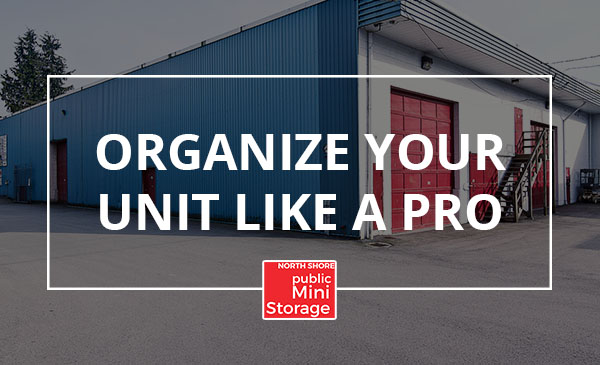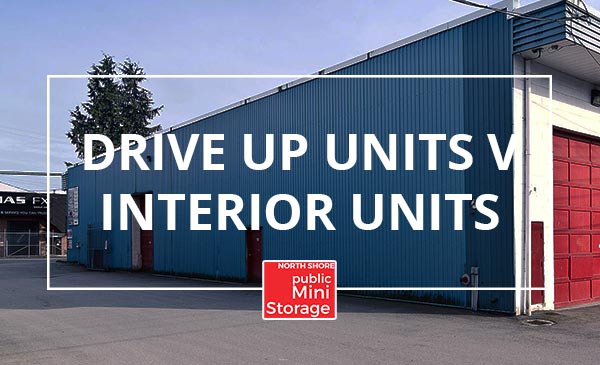- Have any questions?
- 604-929-1507
Organizing your belongings inside your storage unit is an important step you really need to think about when utilizing self storage. If you organize your stuff properly when you first move in, you will be able to easily access anything at any time without stress or hassle. This step is often overlooked. And when it is, that day comes when you need an item all the way in the back and underneath several boxes, and you realize you have to move everything around just to reach it. Well, that’s if you even remember where you put it!
The Best Way to Organize a Storage Unit
All of that can be frustrating, time-wasting, and even dangerous. If you have everything shoved in there with no rhyme or reason, you run the risk of knocking things down, possibly breaking your valuables and items could even fall on top of you causing you harm. But don’t worry, we are here to help! Follow these simple steps to get organized right from the start, and to stay organized over weeks, months, and years.
STEP 1 – Choose the best unit size and type for you and your needs.
A good rule of thumb – it’s better to have too much space than not enough. Most likely you will fill it over time even if you have a little extra when you first move in. Talk with the property manager. Tell them what you will be storing, and they can show you the different options available. Make sure you walk into the unit and visualize what you want to store, and how you think it may fit best. Don’t be shy – ask the property manager for their expert advice. Our property managers are well trained, knowledgeable, helpful, and very friendly. It is their job to be your new BFF. They can help you decide which unit size and type will work best.
STEP 2 – Create a plan.
Never just put things into boxes and into the unit without really thinking about them first. Think about which items you will want to access frequently, which ones you only need on occasion and which ones you won’t need for a very long time. Your plan should have a layout of where each item should be placed and what needs to go inside boxes or totes. Think about what items cannot go inside boxes, and where they will need to be placed in the unit.
If you have large appliances or furniture, plan for these items to go in the back of the unit. Chances are you will not need them at a moment’s notice. If you are storing a sofa or a loveseat, see if these items can be safely stood up on end in the corner to free up more space. You may want to check with the manufacturer to make sure this will not damage the item if stored in this manner for long periods of time. For example, something like a kayak cannot be stored upright, as it will compromise the strength of the product over time and ultimately damage it. It can also be very difficult to stack items on top of the sofa seats. You can potentially damage the cushions or fabric and shorten the lifespan of the springs. Additionally, boxes will not stay evenly stacked because of the springy nature of cushions and can easily fall over.
If you plan to store furniture and mattresses, it’s best to use furniture and mattress covers to protect them from dust and surface damage. When using these covers, you will need to remember to poke a few holes in the plastic to allow the fabric to breathe.
STEP 3 – Pack your items for storage.
Once you have chosen the best unit size and created your detailed plan, the next step is packing your items for storage. First of all, stick to your plan, because doing so will determine how smoothly the move goes, how easily you can access your belongings down the road when you need them and how best you can utilizing every square foot of the unit.
Label your boxes appropriately, and neatly, so you know what is inside at a glance – plan to have markers and labels on hand when packing and moving. Make sure to mark which boxes can go inside larger items like dressers. Wrap valuables and breakables in bubble wrap or packing paper to protect them during the move and while in storage. Don’t pack your boxes too heavily. You want to make sure you can easily pick them up and move them about without hurting yourself or needing assistance. Sometimes using many smaller boxes is easier than using a few large ones, especially if you cannot lift them alone.
Make sure you pack the moving truck or van correctly. Items that are going to be placed in the front of the unit need to be loaded into the truck or van first. All the large items that are going in the back of the unit and along the walls should be loaded onto the truck last, as you will want to unload them first. Many people don’t think about this and end up having to unload the entire truck first so they can pack the storage unit correctly (and according to the plan they created).
Step 3 – Move into the unit.
Stick to the plan. And, if you must stray from it at all, be sure to notate what changes you are making so you don’t have questions later. Large items like furniture and appliances should go in the back and along the outside walls. All items you don’t need regular access to can also be placed toward the back and the corners. Heavy items and boxes need to go on the floor and lighter items and boxes can be stacked on top.
If it’s possible, create an aisle down the center of the unit as a way to access anything located in the back and along the walls. If you are using a really large unit or one that is much wider than it is deep, you can create two aisles; one on the left and one on the right, to access items along both walls, all the way to the back and in the center.
If you are unable to create an aisle down the middle, be sure to keep things you may need often in the front of the unit so they are easily accessible. Things such as important documents, Christmas decorations, children’s winter clothing, tools, and so on.
Be sure to properly label your boxes and totes. This should have been done when you were packing, but it is a good idea to check as you move in. Sometimes you can miss one here or there, or you added some boxes last minute. As you move them into the unit, make sure they are stored with the label facing out or toward the aisle so you can see what is inside quickly. Make sure you write neatly and large enough to see at a distance.
Step 4 – Maximize your storage space.
For example, if you are storing a refrigerator, clean out the inside and stack boxes or items inside it. Make sure you can still get the door open for easy access to those boxes inside. Tape labels on the refrigerator door notating what items are inside. If you are storing a dresser, stack things on top and inside the drawers. Again, make sure there is room to open the drawers and tape labels to the outside stating what’s inside. Don’t put heavy boxes inside the drawers to prevent damaging them. If you are storing a bookcase, you can stack small boxes or items on the shelves.
By storing smaller items and boxes inside your larger items and furniture, you are utilizing the space inside your unit wisely. You will fit more items in the unit this way. Don’t waste space!
Step 5 – Maintain organization from start to finish.
Keep a simple diagram inside your unit that shows where everything is located. Now is the perfect time to create this. You just moved everything into your unit, so it will be fresh in your memory. You can tape this diagram inside the door or on a wall, or even on one of your boxes or large items in the front. Each time you visit and need access to your belongings, refer to the diagram to find things quickly. If you move things around, update the diagram so you are not confused the next time you are there. This step may seem unnecessary to you because you think you’ll remember where you put everything. As time goes by you will forget the placement of some things, no doubt.
So, rather than kick yourself for ignoring this idea, take a few minutes as you move everything in and jot down where you placed it. You will thank yourself later.
Moving can be a really stressful event for many people, nothing is going to change that. However, if you follow these simple steps you can greatly reduce your frustration and moving day will go by more smoothly. Remember to create your plan and stick to it. Get and stay organized. And, if you need help or assistance at any time throughout the process, see your friendly property manager. They are always eager to help!


